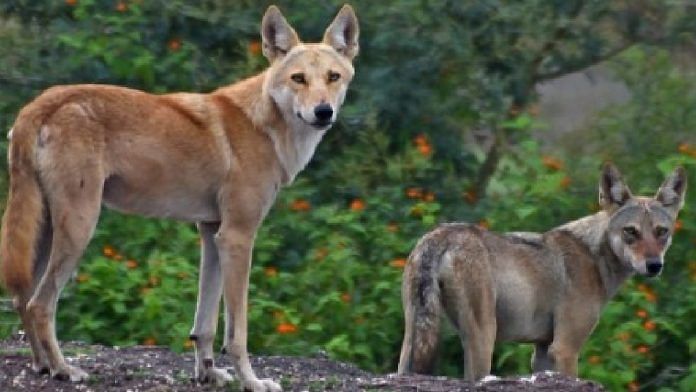New Delhi: Equipped with cameras and zip-lock bags, citizen scientists have helped scientists confirm for the first time in India the existence of a wolf-dog hybrid at Pune — a finding that highlights how the expansion of human habitats is pushing the wildlife to the edge.
The citizen scientists from The Grasslands Trust — which works for wildlife conservation — collaborated with researchers from Bengaluru-based National Centre for Biological Sciences (NCBS) for a project that started early last year to detect wolf-dogs in peninsular India.
NCBS is a premier research centre — under the Tata Institute of Fundamental Research — with focus on biological research.
In the study published in the journal Ecology and Evolution this month, the researchers said that with the expansion of human habitats, the wildlife habitats are becoming increasingly fragmented, “often in proximity to human-modified landscapes”. This results in increased interactions between feral or domesticated animals and wildlife that poses a threat to wild species in terms of hybridisation, disease transmission, predation and scavenging.
The researchers said that the mixing of dog genome into wolves and vice-versa can threaten the wild wolf population, disrupt the social structure of wolf packs and further increase hybridisation rates.
“Since we do not have a tools to monitor how domestic and wild animals are interacting with one another, hybridisation serves a clear indicators that these interactions are happening,” Abhinav Tyagi, one of the researchers at NCBS who was part of the study, told ThePrint.
“Unlike other mammals, both male and females hybrids of canids, or canine — that include dogs, wolves, dholes, jackals, foxes etc — are fertile which means these hybrids are not dead ends,” he added.
These individuals, Tyagi explained, interbreed further, diluting the genetic diversity in the wild. So, the key genetic attributes that enable wolves to be able to survive in the wild might get compromised, threatening the future of the Indian Grey Wolf, he added.
According to the last census, conducted in 2019, there were reportedly 40 wolves in Pune. According to 2022 study by Dehradun-based Wildlife Institute of India, there were reportedly 3,100 wolves in peninsular India.
Known to be the top predator of the grassland, the Indian Grey Wolf is listed as an endangered species by Schedule I of the Indian Wildlife Protection Act, 1972.
Indian Grey Wolf, also known as bhediya, hundar, nekral (in Hindi)/landga (in Marathi), are widely distributed in the parts of Rajasthan, Gujarat, Karnataka, Madhya Pradesh, Maharashtra and Andhra Pradesh. Its habitat ranges from grasslands, thorn forests to scrublands.
The grey wolf is a medium-sized, slender-looking canid, with the shade of taupe to brownish-white coat, streaked with black hair on top, with underparts in white. It has short and thin fur which helps to survive in the scorching summers.
Also Read: 40 tigers have died since start of year, shows govt data. Age, fights, electrocution major causes
The study
The researchers said that although wolf–dog hybridisation has long been speculated to be prevalent in India, there are no published reports with genetic analysis.
In the study, the researchers said that mating between dogs and wolves have been detected by other researchers in the past. However, what has prevented the ability of researchers to confirm such events is fewer number of laboratories that integrate field sampling with conservation genomics in India.
As part of the study, the citizen scientists first spotted and photographed a suspected wolf–dog hybrid individual with “unusual facial features and a tawny coat” near Pune city.
They captured two such instances where an individual in the wolf pack looked different from the others. According to the study, these citizen scientists trailed the suspected hybrid individuals and collected hair samples that the animals shed, in zip-lock bags.
The scientists at the NCBS extracted DNA from the hair samples and carried out genome sequencing. The sequences were compared to previously sequenced samples from 5 Indian wolves, 11 wolves from across different continents, 6 dogs, 3 jackals and 3 dholes.
The results confirmed the presence of wolf-dog hybrids in the region.
Researchers said that hybridisation among canid species is complex. Uma Ramakrishnan, another author of the study and a researcher at the NCBS, told ThePrint: “Why the male hybrids of canid species are not sterile is not well understood.”
“This is just a small study where we have looked at non-invasive samples. Further studies on understanding the breeding patterns of the two species has to be carried out to understand why they are not sterile and what long-term biological characteristics they may have,” she added.
‘Wolves’ conservation a neglected issue’
The researchers said that most conservation efforts in India were focused on issues like examining connectivity, tracking population dynamics, monitoring and assessing prey base and understanding human-wildlife conflict.”
“However, for certain species like wolves, which inhabit regions beyond protected areas and face substantial human-dog interaction, the issue of hybridisation is of significant importance for conservation but remains neglected,” the study said. “We suggest that conservation and management tool kits (guidelines/protocols) should specifically include hybridisation assessment in the future.”
The research also shows how going beyond camera trap, the “eyes on the ground” approach through citizen groups can help investigate rare hybridisation events and the data collected from systematic citizen programmes have helped understand the species distribution and dynamics (movement and interaction with other species in the wild).
Ramakrishnan said that this small study goes a long way to demonstrate the advantages of involving citizen scientists.
“The hybrid individual was spotted by them and the research question was also posed by them. As a researcher, I have my own process of forming research questions, but the approach of those who on the field is different,” she told ThePrint. “With the research tools that we have at NCBS, we can help answer unique research questions.”
(Edited by Anumeha Saxena)



